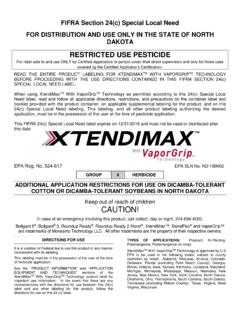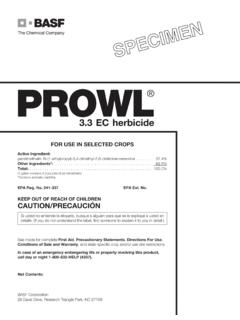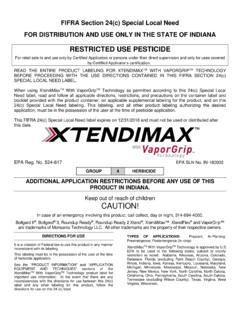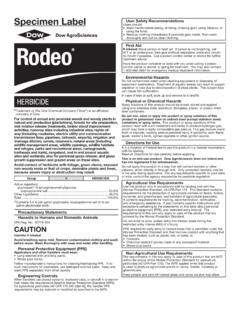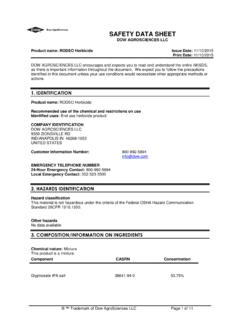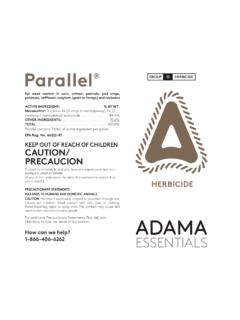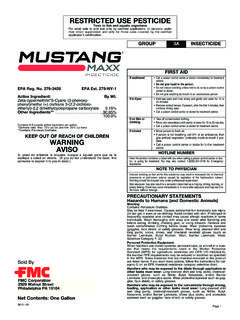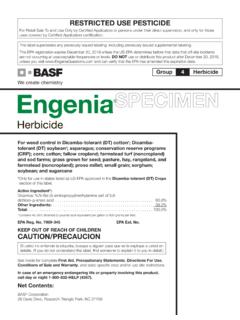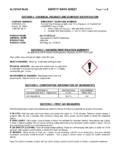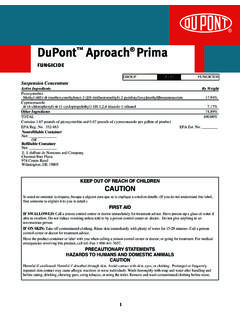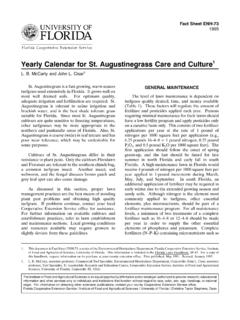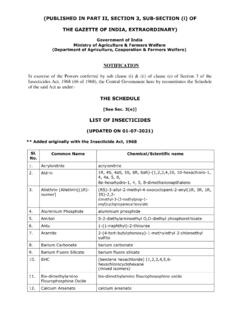Transcription of SUPPLEMENTAL LABEL Weedmaster Herbicide
1 SUPPLEMENTAL LABEL READ AND FOLLOW THE ENTIRE LABEL BOOKLET FOR THIS PRODUCT BEFORE PROCEEDING WITH THE USE DIRECTIONS CONTAINED IN THIS SUPPLEMENTAL LABELING. LABEL as used in this SUPPLEMENTAL labeling refers to the LABEL booklet for this product and this SUPPLEMENTAL . DIRECTIONS FOR USE IT IS A VIOLATION OF FEDERAL LAW TO USE THIS PRODUCT IN ANY MANNER INCONSISTENT WITH ITS LABELING. This LABEL must be in the possession of the user at the time of application. Do not apply this product in a way that will contact workers or other persons, either directly or through drift. Only protected handlers may be in the area during application. For any requirements specific to your State or Tribe, consult the agency responsible for pesticide regulation. ALL APPLICABLE DIRECTIONS, RESTRICTIONS AND PRECAUTIONS IN THE PRODUCT LABEL BOOKLET MUST BE FOLLOWED, INCLUDING STATEMENTS PERTAINING TO THE WORKER PROTECTION STANDARDS, ON THE EPA REGISTERED LABEL .
2 NON-CROP APPLICATIONS RIGHTS-OF-WAY (RAILROAD, ROADSIDES, UTILITY, PIPELINE), NON-SELECTIVE FOREST BRUSH CONTROL, INDUSTRIAL SITES, NON-IRRIGATION DITCHBANKS, AND OTHER NON-CROP AREAS. SPECIES CONTROLLED When used as directed, this product will control or suppress many herbaceous broadleaf weeds (annual, biennial, and perennial) as well as many unwanted woody plant and vine species. Species controlled include: ANNUALS Buckwheat, wild Cocklebur Lambsquarter Purslane Carpetweed Daisy, English Morningglory Ragweed Chickweed Henbit Mustard Smartweed Clover Knawl Pigweed Velvetleaf BIENNIALS Ragwort, Tansy Thistle, Musk PERENNIALS Bindweed, Field Dogfennel Sorrel, Sheep Carrot, Wild Knapweed, Russian Spurge, Leafy (Queen Anne's Lace) Milkweed Thistle, Canada Dock, Curly Ragweed, Perennial Toadflax, Dalmatian Weedmaster Herbicide EPA Reg. No. 71368-34 LABEL REVISIONS: FOR CONTROL OF BRUSH AND BROADLEAF WEEDS ON RIGHTS-OF-WAY, FOREST BRUSH, INDUSTRIAL SITES, NON-IRRIGATION DITCHBANKS, FENCE ROWS, AND OTHER NON-CROP AREAS.
3 2 WOODY BRUSH AND VINES Alder Cucumber tree Locust Redcedar, Eastern* Snowberry Ash Dogwood* Maple Redvine Spruce Aspen Elderberry Oak Rose, Multiflora* Sumac Basswood Elm Olive, Russian Sagebrush Sycamore Beech Gum Permission Sassafras Trumpetcreeper Birch Hawthorn* Pine Schinus Waxmyrtle Blackberry* Hemlock Plum, Wild* (Florida Holly, Willow Cherry Honeysuckle Poplar Brazil Peppertree, Witchhazel Creeper, Virginia Ivy, Poison Puncturevine Christmas-berry) Yaupon* Creosotebush* Kudzu Raspberry Serviceberry *Suppression RATES Regardless of the species to be controlled, spray volumes should be high enough to allow for good spray coverage. Make applications when weeds and brush are actively growing. The addition of surfactants can increase control. Biennials are best controlled when treated in the rosette stage. Regrowth may occur on resistant species. Do not exceed quarts per treated acre during the growing season of this product per treated acre.
4 To control additional weed species, this product may be tank mixed with any of the products listed on this LABEL . RESTRICTIONS Preemergence (annual and perennial weeds):Limited to 2 applications per year. Maximum of quarts ( lbs. ae 2,4-D) per acre per application. Minimum of 30 days between applications. Limited to 1 application per year. Postemergence (woody): Maximum of 11 quarts ( lbs. ae 2,4-D) per year. Applications to non-cropland areas are not applicable to treatment of commercial timber or other plants being grown for sale or other commercial use, or for commercial seed production, or for research purposes. HERBACEOUS BROADLEAF WEED CONTROL Apply 1 to quarts of this product in 20 to 100 gallons of water per treated acre, (3/4 to 2 ounces per 1,000 square feet). When using low-volume application equipment, 3 to 20 gallons of water per acre is acceptable. 1 to 2 quarts (3/4 to ounces) of this product is recommended for annuals, to quarts ( to 2 ounces) for biennials and easy-to-kill perennials, and quarts for established perennials.
5 Do not apply more than quarts of product per treated acre. BRUSH AND VINE CONTROL High Volume Foliar Spot Applications: Mix to quarts of this product in enough water to make 100 gallons of spray mix. When using low-volume application equipment, 3 to 20 gallons of water per acre is acceptable. Spray volume applied will depend on the size and density of the brush to be treated, but do not apply more than quarts of product per treated acre. Direct the spray to treat all foliage, stems, and root collars to wet. Broadcast Applications with Ground Equipment: Apply to quarts of this product in 20 to 100 gallons of water per treated acre. When using low-volume application equipment, 3 to 20 gallons of water per acre is acceptable. Spray volume applied will depend on the size and density of the brush to be treated, but do not apply more than quarts of product per treated acre. Spray all foliage, stems and root collars to wet. AERIAL APPLICATIONS Aerial applications may be made to control either herbaceous or woody plants.
6 Apply 1 to quarts of this product (for herbaceous weeds) or to quarts of this product (for woody brush and vines) in 5 to 40 gallons of water per treated acre. Coverage is important, so increase spray volume when treating dense stands of brush or weeds. Do not apply more than quarts of product per treated acre. TANK MIX TREATMENTS READ AND FOLLOW THE LABEL OF EACH TANK MIX PRODUCT USED FOR PRECAUTIONARY STATEMENTS, DIRECTIONS FOR USE, AND OTHER RESTRICTIONS. For broader spectrum control, this product may be tank mixed with one or more of the following herbicides for noncropland uses ( railroad, highway, pipeline, etc.) 3 including forest management, pastures and rangeland applications, if permitted by product labeling ( 2,4-D). Add water to the spray tank prior to the addition of the tank mix products. Do not premix concentrates. Herbicide RATE (LBS. ACRE) Amitrol* asulam (Asulox ) Atratol Bromacil (Hyvar ) Clorflurecol (Maintain ) Chlorsulfuron (Chlorsulf E-Pro) Dalapon Dicamba (Diablo ) Diquat Diuron (Karmex ) Fenac (Fenatrol ) Fosamine ammonium (Krenite ) Glyphosate (Razor ) Hexazinone (Velpar )I mazapyr** (Polaris ) Limit ** Maleic hydrazide (Royal Slo-Gro ) Mefluidide (Embark ) Metsulfuron Methyl (Patriot )1 MSMA Paraquat* Picloram* (Trooper ) Simazine* (Princep ) Sulfometuron methyl (Oust ) Tebuthiuron (Spike ) Triclopyr (Tahoe ) 2,4-D 2,4-DP to to to to to to oz.
7 ** to to ** to to to to to to to to to to ** to to to to oz.** to to to ** to Due to variations that may occur in formulated products and specific use ingredients ( water supplies) a COMPATIBILITY TEST as described below is recommended prior to actual tank mixing. * Restricted use pesticides limited to certified applicators. ** Limit does not have a common name. ** Chlorsulf E-Pro = to ounces ( to ounces product/acre) Oust = to oz. ( to ounces product/acre) Patriot = to oz. ( to ounces product/acre) ** Do not exceed a total of 2 pounds dicamba per treated acre per growing season. (This product contains 1 pound. dicamba per gallon.) ** Use of extremely hard water (500 ppm) may cause this product to form a precipitate when used in a tank mix with this product. Do not exceed 4 pounds total 2,4-D acid equivalent per acre per application per site.
8 Using this product and Patriot to reduce the development and spread of resistant biotypes and problem weeds such as Kochia and Russian thistle: Some commonly resistant weeds typically require multiple spray applications to obtain adequate control. To reduce the number of applications required, applicators can utilize a mixture of Patriot and this product. Apply as a tank mix for postemergence as follows: Add ounce of Patriot to 1 quart of this product per acre. A non-ionic or silicone surfactant may be used for wetting, penetration or drift control. NOTE: All intended tank mix combinations should be used only in recommended areas on the same broadleaf weed species found on both labels. For application methods and other use specifications, use the most restricted limitations from labeling of both products. 4 COMPATIBILITY TEST Before mixing in the spray tank, it is advisable to test compatibility by mixing all components in a small container in proportionate quantities (see following table).
9 AMOUNT OF Herbicide TO ADD TO ONE PINT OF SPRAY CARRIER (ASSUMING VOLUME IS 25 GALLONS PER ACRE) Herbicide RATE FORMULATIONS LEVEL PER ACRE Dry TEASPOONS 1 pound 1-1/2 Liquid 1 pint 1/2 If Herbicide (s) do not ball-up or form flakes, sludge, gels, oily films or layers, or other precipitates, then the tested components are compatible. Usually incompatibility in any of the above described forms will occur within 5 minutes after mixing. If components are incompatible, the use of a compatibility agent is recommended. Rerun the above COMPATIBILITY TEST with a suitable compatibility agent (1/4 teaspoon is equivalent to 2 pints per 100 gallons of spray solution). PROCEDURE FOR CLEANING SPRAY EQUIPMENT The steps listed below are suggested for thorough cleaning of spray equipment following applications of this product or tank mixes of this product plus 2,4-D Amine. 1) Hose down thoroughly the inside as well as outside surfaces of equipment while filling the spray tank half full of water.
10 Flush by operating sprayer until the system is purged of the rinse water. 2) Fill tank with water while adding 1 quart of household ammonia or 1/4 pint of Neutral-Clean for every 25 gallons of water. Operate the pump to circulate the ammonia solution through the sprayer system for 15 to 20 minutes and discharge a small amount of the ammonia solution through the boom and nozzles. Let the solution stand for several hours, preferable overnight. 3) Flush the solution out of the spray tank through the boom. 4) Remove the nozzles and screens and flush the system with two full tanks of water. The steps listed below are suggested for thorough cleaning of spray equipment used to apply this product as a tank mix with wettable powders (WP), emulsifiable concentrates (EC), or other types of water-dispersible formulations. Tank mixing this product with water-dispersible formulations, requires the use of a water/detergent rinse. 5) Complete step 1.
